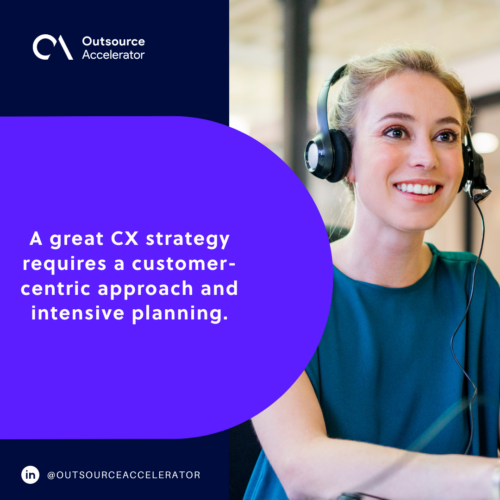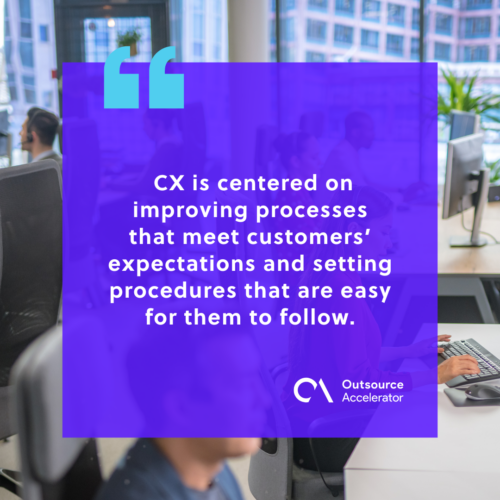Seven critical CX strategies to help scale your revenue growth

Businesses that strive to provide an exceptional customer experience (CX) confront difficulties due to increased customer demands and expectations.
A great CX strategy requires a customer-centric approach and intensive planning. Through this, your business can promote loyalty, helps you retain customers, and encourage brand advocacy.
The concept of customer experience has evolved significantly during the past several years. Today, the objective is to make it as seamless as possible.
To be successful in business and get ahead of the competition, you must rethink and organize your CX strategy. Consider the consumer demands and shorten the gap between your business goals and customer needs.
This article covers CX strategies you can add to your existing customer experience strategy.

What is customer experience (CX)?
Customer experience (CX) is defined as the interactions and experiences between a customer and a company. This includes the whole client journey, from initial contact to becoming a satisfied and loyal customer.
Customer experience is integral to customer relationship management (CRM) because it demonstrates a clear investment in the customer’s journey.
From the discovery and checkout process to post-purchase, your brand image is primarily influenced by how good or bad your customers’ experience is.
In other words, CX is centered on improving processes that meet customers’ expectations and setting procedures that are easy for them to follow.

How important is the customer experience?
Customer experience is essential because a customer with a positive experience is likelier to become loyal.
Customer expectations today are higher than before because of the rise of digital transformation in a digital ecosystem.
Competitors are also leveraging the power of AI to entice customers. Helpware is a forerunner in this endeavor with its AI customer service solutions.
Therefore, excellent customer experience management is essential because it aids brand loyalty and the financial hurdles of the company.
When interacting with brands, customers go through several touchpoints, so improving a business’s CX strategy helps support the overall customer experience.
Some of the primary customer touchpoints are the following:
- Brand promise. The content of the brand is the same as the advertisement.
- Brand story. Your brand’s difference from competitor brands.
- Purchasing process. A convenient and easy purchasing process moves the customer to repeat purchases.
- Experience. Consistency is present throughout the repeat process of the customer’s journey.
One bad experience at any touchpoint can derail all your efforts to deliver a great customer experience.
Customer experience vs customer service
Customer experience and customer service are distinct yet interdependent.
Customer experience is customers’ overall perception based on the touchpoints throughout their journey. In contrast, customer service refers to the assistance or advantage businesses offer to their clients and consumers.
CX is a broader concept than customer service. It applies across marketing, sales, support, and operations. However, customer service is a large part of the end-to-end customer experience.
Seven critical CX strategies to scale revenue growth
A successful customer experience is dependent on CX strategies that organizations have and take the following factors into account:
- Competitive insight
- Consumer research
- Marketplace data
- Mission & Vision
Another thing to note is that, for CX strategies to be efficient, they should incorporate feedback and insights across the company.
Here are seven critical CX strategies to scale your revenue growth:
1. Discover the brand experience
Before developing a CX strategy, you must discover what others think about your brand.
You can release a ‘test’ brand and gather feedback to see how first-time consumers will react upon using the product and how popular it can get in the market.
Your CX lead should discover how customers perceive your brand. Be aware of your brand’s weaknesses, so you can develop a defensive plan alongside your CX strategy.
2. Research current consumers
This is a critical element of CX strategies.
Perform a situational analysis using both qualitative and quantitative research. It should include an in-depth customer and employee survey and web analytics.
This data collection will allow you to acquire insights to help you design your strategy and understand where your company is in the eyes of the consumer.
3. Research the competition
Identifying your competition and understanding what they do to make their businesses stand out is vital for your firm’s success.
It is crucial to understand the competitors’ current business strategies to stay up with the ever-changing market environment and dynamics.
4. Analyze business objectives
Analyzing business objectives is a critical part of CX strategies. It allows an organization to understand its environment and formulate a strategic plan accordingly.
To understand your company’s strategic priorities, ask the right questions about your current business objectives.
- Is the current objective to win new customers or broaden the revenue stream from existing customers?
- Is the business entering new markets or bringing new products & service offerings into the current one?
5. Align business process with CX opportunities
Gaining a 360-degree perspective of your business helps you to:
- Reorganize goals to generate enduring value through a CX strategy
- Identify obstacles to achieving objectives
- Outline how a CX strategy will achieve objectives
Knowing the purpose, values, and procedures will assist in answering the fundamental questions around a CX strategy.
6. Map the customer journey
Client data collection and analysis will give crucial insights into your company’s existing and potential customer base in terms of the following areas:
- Customer requirements
- Customer wants
- Major pain areas
The customer journey map may then be utilized to carry out a gap analysis to understand better the areas in which the company is lacking, which will guide the new CX strategy.
7. Measure your CX strategy
It is necessary to have a basis for assessing your progress. For example, KPIs determine whether or not your CX strategy has been successful.
These metrics typically fall into three categories:
- Descriptive
- Perceptive
- Outcome-based
When you measure your CX strategy, it will support your company in setting future goals and prepare your team and organization for further improvements.
Apply these methods to your current strategy
Developing an efficient plan for the CX experience involves ensuring that your clients get the goods and services they want promptly.
Every company needs to understand the significance of providing their clients with quality service and incredible experience.
When you deliver a fantastic customer experience, you create substantial value for your customers and business.
You may use the abovementioned ideas in your current CX plan to accelerate your revenue development.







 Independent
Independent




